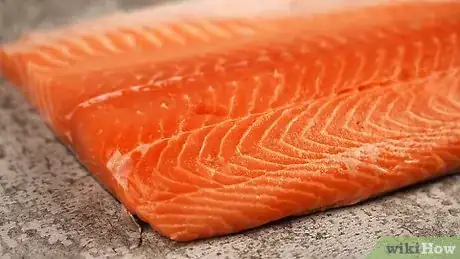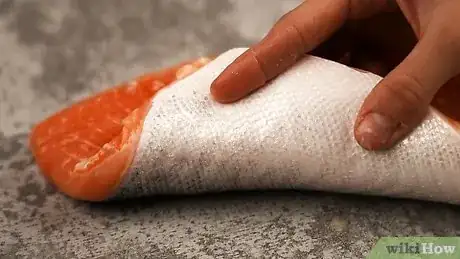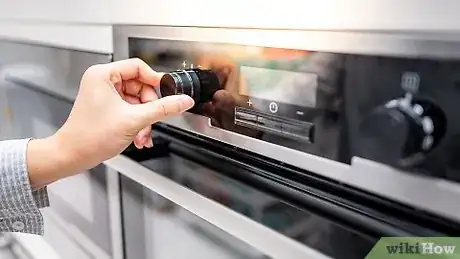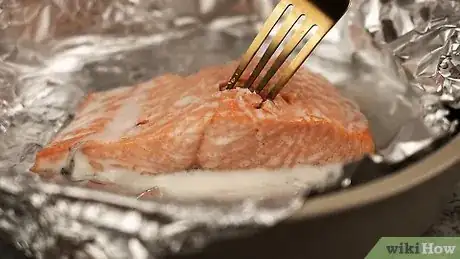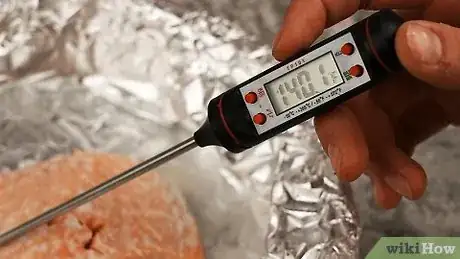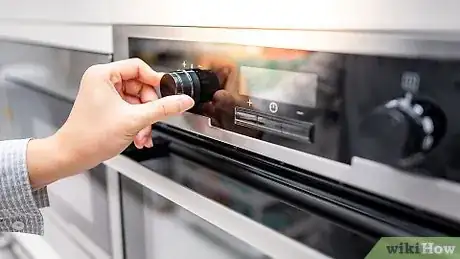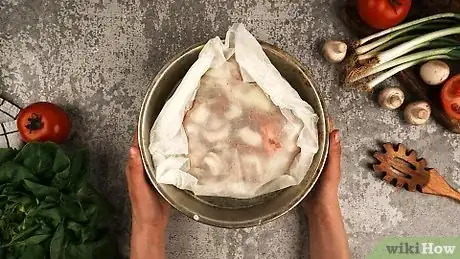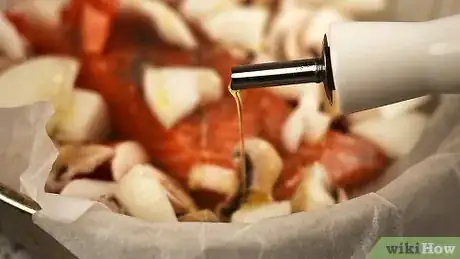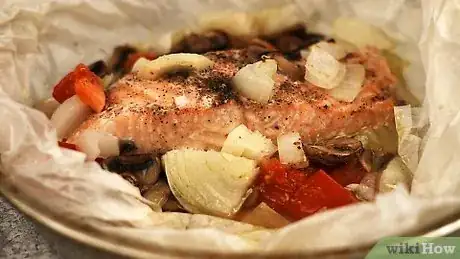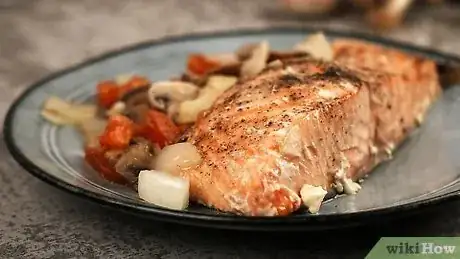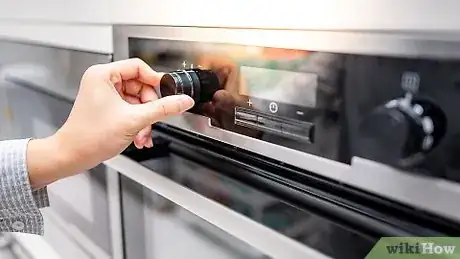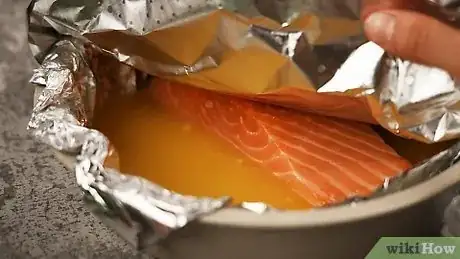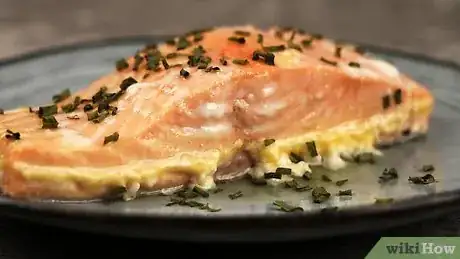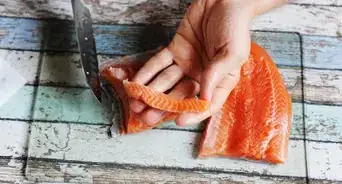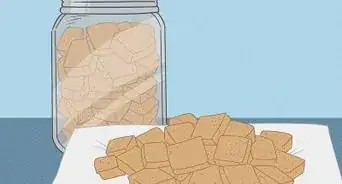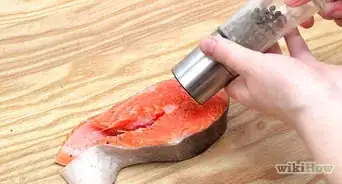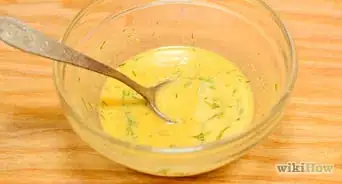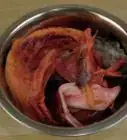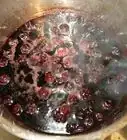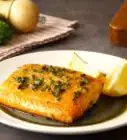This article was co-authored by Marrow Private Chefs. Marrow Private Chefs are based in Santa Rosa Beach, Florida. It is a chefs’ collaborative comprised of an ever-growing number of chefs and culinary professionals. Though regionally influenced primarily by coastal, traditional southern, cajun, and creole styles and flavors, the chefs at Marrow have a solid background in all types of cuisine with over 75 years of combined cooking experience.
wikiHow marks an article as reader-approved once it receives enough positive feedback. In this case, several readers have written to tell us that this article was helpful to them, earning it our reader-approved status.
This article has been viewed 1,289,864 times.
There are many ways to bake salmon. The best method to employ will depend on factors like personal tastes, the time of the year, and what seasonal ingredients are available. This article provides general guidelines to follow when preparing baked salmon.
- Prep time (Traditional Baking): 15 minutes
- Cook time: 40-60
- Total time: 55-75 minutes
Ingredients
- Whole salmon fillets
Steps
Traditional Baking
-
1Buy whole salmon fillets when preparing baked salmon. The flesh can range in color from a pale pink to a deep red, depending on the salmon species available. A salmon fillet is cut in half lengthwise down the middle of the fish. The pink flesh is exposed on one side, and the skin (typically scaled) on the opposite side.
- Depending on your location and the time of year, you may find Atlantic, Coho, Chinook, Sockeye, and King, wild, farmed, fresh, or frozen. Each option features subtle differences in taste, texture, and appearance.
-
2Leave the skin on the fillet and bake skin-side down. Cooking fish with the skin-side down helps retain its moisture during the cooking process. This is especially important when baking salmon, as it tends to dry out easily.Advertisement
-
3Set the oven temperature between 325 ºF/175ºC and 375ºF/190ºC. The right temperature depends on the recipe used and the size of the fillet being baked. Set the oven to the lower end of the temperature range for smaller fillets and the higher end for larger fillets. Cooking the fish at too high or too low of a temperature will dry it out.
-
4Cook the salmon fillet in a covered, oven-proof baking dish. Keep the fish covered during the process, as it helps the fish retain its moisture and speeds up the cooking time.
-
5Check the fish often, as cooking times vary, widely depending on the equipment used and the size of the fillet. A small fillet may only require 25 to 30 minutes, while a large fillet could take 40 to 60 minutes to bake.
-
6Use a meat thermometer if available. A meat thermometer can be purchased at most grocery or kitchen stores, and it takes the guesswork out of baking salmon. Insert a meat thermometer into the thickest portion of the fillet and remove the salmon from the oven when the temperature reaches 140ºF/60ºC.
Baking en Papillote (in paper)
-
1Preheat the oven to 350ºF/177°C. Although you will be wrapping the salmon in parchment paper, the oven doesn't need much extra in terms of heat. Cooking salmon or any other type of fish, in parchment paper is a very efficient way of baking, and almost fool-proof. Cleaning up the surface of where your baking is as easy as throwing away a piece of paper.
-
2Prepare the salmon. When cooking en papillote, it's generally best to:
- Leave the skin on the fillet and bake skin-side down.
- Rinse the fillets in cold water, dabbing the fillets dry with paper towels or letting air-dry.
- Season with salt and pepper.
-
3Fold the parchment paper in half crosswise. Place the parchment on a baking sheet. Center the salmon fillet onto one side of the parchment paper.
-
4Place any herbs, aromatics, or vegetables into the parchment with the salmon. Baking en papillote is an opportunity to cook vegetables and other seasoning along with the fish. Here are some combinations that work well with salmon that you might want to consider:
- Lemon, capers, and rosemary. Lemon and salmon is a classic, as is the addition of tangy, briny capers. Add some fresh rosemary to the mix for a burst of life.
- Asparagus, lemon, and onion. Chop up some asparagus and add it in with the salmon, complementing with lemon and red onion. The onion will turn out sweet and the lemon will help the salmon taste light and moist.
- Dill and lemon. Dried dill has a very mild, almost-anise flavor, making it a perfect complement to the salmon if you don't want to overpower it. Don't forget the lemon juice!
- Tomatoes, zucchini, and mushrooms. For a heartier dish, try adding these summer vegetables. (No need to cook them first.) A spritz of lemon or an entire lemon wedge is never a bad addition to a combo like this.
-
5Add olive oil and/or white wine. After you've decided on your seasonings and vegetables, drizzle a bit of olive oil onto the salmon. A tablespoon of white wine will help keep the salmon and vegetables moist and flavorful.
- Butter will work as a substitute for olive oil. For a deeper flavor, add a tablespoon of butter into the parchment instead of olive oil.
-
6Fold the parchment to seal the salmon and vegetables. Fold the parchment over the salmon, creating a triangle. Starting at the bottom, fold the edges of the parchment over, creating several overlapping sections. This will make a seal, allowing the salmon and any vegetables to cook in their own juices.
- Do not tape the parchment paper together. While you want a good seal on your fish, you do not want to completely capture all the air inside the parchment. A small amount of escaped air is fine.
- Do not fold the parchment too tightly. Leave ample room in the paper chamber for the salmon and vegetables. Your parchment should be snug without being cramped.
-
7Bake at 350°F/180ºC for 20 to 25 minutes. You want the salmon fillet to be opaque and flaky. Translucent, reddish flesh means the salmon has not yet fully cooked.
-
8Remove from the oven and serve. Transfer all ingredients to a separate platter, or simply cut open the parchment and serve as is.
-
9Finished.
Baking with Orange Juice
-
1Set the oven at 325ºF/175ºC.
-
2Place the salmon in a dish. Pour orange juice into the dish, adding enough so that it just covers the piece of salmon.
-
3Cover the dish with aluminum foil.
-
4Bake until it's done. This will take around twenty to thirty minutes.
-
5Serve. It goes very well with rice.
Expert Q&A
-
QuestionHow can you remove salmon skin after baking?
 Marrow Private ChefsMarrow Private Chefs are based in Santa Rosa Beach, Florida. It is a chefs’ collaborative comprised of an ever-growing number of chefs and culinary professionals. Though regionally influenced primarily by coastal, traditional southern, cajun, and creole styles and flavors, the chefs at Marrow have a solid background in all types of cuisine with over 75 years of combined cooking experience.
Marrow Private ChefsMarrow Private Chefs are based in Santa Rosa Beach, Florida. It is a chefs’ collaborative comprised of an ever-growing number of chefs and culinary professionals. Though regionally influenced primarily by coastal, traditional southern, cajun, and creole styles and flavors, the chefs at Marrow have a solid background in all types of cuisine with over 75 years of combined cooking experience.
Private Chefs Use a spatula—the meat will separate from the skin very easily and you can enjoy the salmon skin-free.
Use a spatula—the meat will separate from the skin very easily and you can enjoy the salmon skin-free. -
QuestionThe white stuff on the salmon, is that good?
 MicheleTop AnswererWhile unappealing, it's simply the albumin which gets pushed out of the muscle fibers as it cooks. 10 minutes in a brine solution of 1 tsp per cup of water before cooking should reduce the amount.
MicheleTop AnswererWhile unappealing, it's simply the albumin which gets pushed out of the muscle fibers as it cooks. 10 minutes in a brine solution of 1 tsp per cup of water before cooking should reduce the amount. -
QuestionI am baking salmon for 20 guests. How many fillets, how long in the oven, and covered or not covered?
 MicheleTop AnswererIf you're cooking for that many, I would choose the en papillote (in paper) version. This way you can prep all the portions early in the day or the day before and hold them in the fridge till ready to cook. Place the portions on sheet pans and cook for the same amount of time suggested, 20 - 30 minutes. You may need to add time for thicker cuts. If your portions are uneven, place the thinner cuts to the front so you can remove them first and allow the thicker cuts to cook longer.
MicheleTop AnswererIf you're cooking for that many, I would choose the en papillote (in paper) version. This way you can prep all the portions early in the day or the day before and hold them in the fridge till ready to cook. Place the portions on sheet pans and cook for the same amount of time suggested, 20 - 30 minutes. You may need to add time for thicker cuts. If your portions are uneven, place the thinner cuts to the front so you can remove them first and allow the thicker cuts to cook longer.
Warnings
- Be careful not to confuse salmon steaks with salmon fillets. A salmon steak is 1 thick slice of a whole salmon fillet and will cook much more quickly than a whole side of salmon. Salmon steaks are typically skinned and boned and should be cooked at a lower temperature than a whole fillet.⧼thumbs_response⧽
References
- http://www.thecitycook.com/cooking/advice/essential_kitchen/000017
- http://www.bigoven.com/recipe/159960/spicy-baked-salmon
- http://www.allrecipes.com/recipe/219188/carlys-salmon-en-papillote-in-paper/
- Larousse Gastronomique, compiled by Robert J. Courtine, edited by Jennifer Harvey Lang, published by The Hamlin Publishing Group, 1995.
About This Article
To bake salmon, first preheat your oven to 450°F (230°C) and line a baking sheet with aluminum foil. Then, place the salmon skin-side down on the sheet. Brush the top and sides of the salmon with olive oil, then season with salt and pepper. Bake the salmon for 4 to 6 minutes per ½ inch (1 ½ cm) of thickness. You’ll know it’s done when the inside of the fish is opaque and flaky. To make a lemon, garlic, and dill seasoning for your salmon, first pour ½ cup (120 mL) of melted butter and 4 tablespoons (60 mL) of lemon juice into a small bowl. Then, add 7-8 cloves of crushed garlic and 2 tablespoons (6 g) of chopped dill. Stir everything together, then pour the mixture over your salmon before baking it. If you want to learn how to wrap your salmon before you cook it, keep reading the article!
